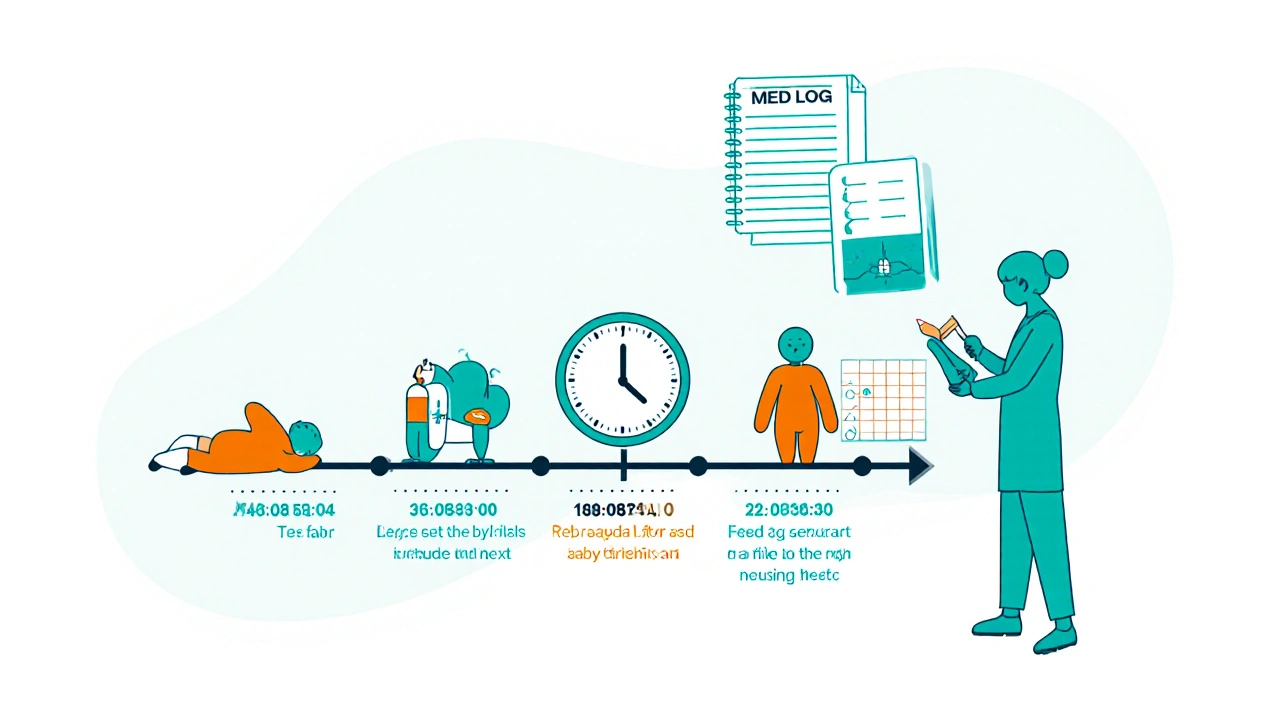Breastfeeding Antidepressant Safety Calculator
Calculate Your Antidepressant Safety
This tool calculates the relative infant dose (RID) of antidepressants in breast milk and provides safety guidance for breastfeeding mothers.
Safety Assessment
postpartum depression treatment is a delicate balance between a mother’s mental health and her baby’s safety while nursing. Below you’ll find a plain‑language guide that cuts through the jargon, shows which medicines are generally safe, and offers practical steps for moms and clinicians.
Quick Takeaways
- Untreated PPD poses a bigger risk to mother and infant than most antidepressant exposure through breast milk.
- Sertraline and paroxetine have the lowest relative infant doses (RID < 5%) and are first‑line choices for breastfeeding moms.
- Fluoxetine, doxepin, and high‑dose bupropion carry higher RID and may cause infant irritability or sedation.
- Zuranolone, the newest oral PPD drug, shows low milk transfer but current guidelines still advise pumping and discarding milk for a week after the last dose.
- Monitor infants for sedation, feeding problems, or excessive fussiness during the first 2-4 weeks of maternal therapy.
What Is Postpartum Depression and Why Lactation Matters
Postpartum Depression is a mood disorder that affects roughly one in eight women after childbirth. It goes beyond the “baby blues” with persistent sadness, anxiety, and functional impairment that can last months if left untreated. The American College of Obstetricians and Gynecologists (ACOG) defines it as depressive symptoms appearing within the first six weeks postpartum and lasting more than two weeks.
Breastfeeding offers nutritional and bonding benefits, yet new mothers with PPD often struggle to start or keep up with nursing. Studies show the relationship is bidirectional: depression can hamper milk production, and breastfeeding difficulties can worsen mood. Because of this feedback loop, clinicians must consider both mental‑health treatment and lactation support together.
How Antidepressants Reach the Baby: Key Pharmacokinetic Concepts
When a mother takes a medication, a portion can pass into breast milk. The main metric used is the Relative Infant Dose (RID), calculated as:
- Infant’s daily milk intake (mL/kg) × drug concentration in milk (mg/mL)
- Divided by the mother’s daily dose (mg/kg)
An RID under 10 % is generally deemed compatible with breastfeeding. Most antidepressants fall well below that threshold, but the exact percentage varies by drug class.

Comparing Common Antidepressants for Breastfeeding Moms
| Medication | Class | Typical RID % | Infant Serum Detectability | Key Infant Side Effects Reported |
|---|---|---|---|---|
| Sertraline | SSRI | 0.5-3.2 | Undetectable in 92 % of cases | Rare irritability; most infants unaffected |
| Paroxetine | SSRI | 0.9-8.6 | Low‑level detection occasional | Mild sedation reported at higher doses |
| Citalopram | SSRI | 3.5-8.9 | Detectable in 10 % of infants | Potential QT prolongation at high maternal doses |
| Fluoxetine | SSRI | 5.9-15.2 | Detectable; accumulation over weeks | Irritability, occasional sleep disruption |
| Venlafaxine | SNRIs | 1.4-5.9 | Low‑level detection | Irritability when maternal dose >150 mg/day |
| Zuranolone | GABA‑modulator (PPD‑specific) | 0.5-1.5 (estimated) | Not yet systematically measured | Guidelines advise pumping & discarding for 1 week post‑treatment |
| Fluoxetine | SSRI | 5.9-15.2 | Detectable; metabolite norfluoxetine can reach 30 % of maternal levels | Potential sedation, feeding issues |
| Bupropion | NDRI | 6-10 | Low‑level detection | Increased seizure risk in premature infants (theoretical) |
Rows are ordered from lowest to highest RID. The data combine LactMed reports, meta‑analyses, and real‑world surveys up to 2024.
Practical Steps for Moms and Clinicians
- Screen early and often. Use the Edinburgh Postpartum Depression Scale (EPDS) at 1, 2, 4, and 6 months well‑visits. A score ≥ 13 flags possible PPD.
- Pick the safest drug first. Start with sertraline 25-50 mg daily or paroxetine 10-20 mg daily. These doses achieve therapeutic effect while keeping RID under 5 %.
- Time the dose. Take the medication right after a feeding session, then breastfeed again 3-4 hours later to maximize the gap between peak milk concentration and nursing.
- Watch the baby. For the first 2-4 weeks, observe for excessive sleepiness, poor feeding, or unexplained fussiness. If any sign appears, contact your pediatrician.
- Adjust if needed. If side effects emerge, consider lowering the dose or switching to another low‑RID SSRI. Most mothers tolerate a dose increase after the initial adjustment period.
- Document and communicate. Keep a medication log, note infant reactions, and share it with both your psychiatrist and pediatrician. Coordination reduces unnecessary medication changes.
Clinicians should also counsel mothers that abrupt discontinuation of antidepressants raises relapse risk by threefold, so any taper must be gradual.

Monitoring Infant Safety
Infant monitoring is simple but essential:
- Weight gain: track at each well‑visit; a drop >5 % warrants evaluation.
- Feeding patterns: note any prolonged naps after feeds or refusal to nurse.
- Behavioral cues: excessive crying, colic‑like episodes, or unusual lethargy may signal drug exposure.
- When in doubt, pediatric labs can measure serum drug levels, although this is rarely needed for low‑RID SSRIs.
Special populations-preterm infants, those under 2 months, or infants with congenital conditions-require closer observation, as highlighted by the InfantRisk Center.
Frequently Asked Questions
Can I breastfeed while taking sertraline?
Yes. Sertraline has the lowest RID among SSRIs (0.5-3.2 %). Most studies report no detectable infant serum levels, and over 90 % of breastfeeding mothers experience no infant side effects.
What should I do if my baby seems fussy after I start an antidepressant?
First, rule out common causes like feeding position or gas. If fussiness persists for more than a few days, contact your pediatrician. A dose reduction or switch to another low‑RID drug (e.g., paroxetine) often resolves the issue.
Is zuranolone safe for nursing moms?
The drug shows low estimated milk transfer (0.5-1.5 % RID), but current ACOG guidance recommends pumping and discarding milk for one week after the last dose until more data are available.
How long does it take for fluoxetine to clear from my baby’s system?
Fluoxetine’s half‑life is about 4‑6 days, and its active metabolite norfluoxetine can persist longer. It may take 2‑3 weeks of stopping the drug for infant serum levels to drop below detectable limits.
Do I need to stop breastfeeding if I start an antidepressant?
In most cases no. Professional societies agree that the benefits of continuing to breastfeed outweigh the low risk of drug exposure, especially with SSRIs like sertraline. Only certain high‑RID agents or severe infant reactions would prompt a temporary pause.
Bottom Line
The key is not to choose between mental health and breastfeeding-treat both together. Start with a low‑RID SSRI, monitor the infant, and adjust only if problems arise. With careful selection and vigilant follow‑up, mothers can protect their own wellbeing while still providing the nutritional and emotional benefits of breast milk.

9 Comments
Zaria WilliamsOctober 24, 2025 AT 20:32
Look, moms gotta know that not every SSRI is a free pass. Sertraline and paroxetine are the real MVPs, the rest can leave your baby jittery or sleepy. You dont want to be the one scrambling for a pediatrician because your little one is unusually fussy. The guide nailed the RID numbers, so stick to low‑RID meds if you can. And seriously, stop scrolling through endless anecdotal blogs – trust the data, not the drama.
ram kumarNovember 1, 2025 AT 05:32
Ah, the tragic opera of modern motherhood, where every pill becomes a courtroom drama. You’d think we’d have a crystal ball by now, but nope, just a table of percentages. My heart aches for the poor infant who must endure a dose of parental indecision. Truly, the world is a bleak stage of half‑baked research.
Melanie VargasNovember 8, 2025 AT 15:32
Hey lovely community! 🌟 Let’s remember that every mom’s journey is unique, and the safest route is a shared decision with her doctor. The table you posted is gold, but don’t forget to pair meds with lactation support – a good latch can boost mood too. Feel free to drop any questions, we’re all here to lift each other up! 💖
Deborah GallowayNovember 16, 2025 AT 01:32
Thank you for the thorough breakdown; it really helps to demystify a topic that can feel overwhelming. First, I want to acknowledge how brave it is for any mother to seek help for her mental health while also caring for a newborn. The balance between treating postpartum depression and maintaining breastfeeding is delicate, but absolutely achievable with the right plan.
Sertraline’s low RID makes it a solid first‑line choice, and most studies show infants have undetectable serum levels, which eases many parents’ worries.
Paroxetine follows closely, though a bit higher on the RID scale, still well under the 10 % safety threshold.
When higher‑RID meds like fluoxetine are considered, it’s essential to monitor the baby closely for changes in sleep or feeding patterns.
Keep a simple log: date, dose time, feeding time, and any infant behavior changes – this can be a lifesaver during follow‑up appointments.
Remember, the infant’s weight and feeding volume can affect the actual dose they receive, so regular weight checks are key.
If you notice increased fussiness, try adjusting the time of your dose to right after a feeding, allowing a gap before the next nursing session.
For newer agents like zuranolone, the recommendation to pump and discard for a week may feel daunting, but it’s a prudent precaution until more data emerge.
Don’t let the fear of medication stop you from getting help; untreated depression poses greater risks to both mom and baby than most medication exposures.
Collaborate with both your psychiatrist and pediatrician – communication ensures everyone is on the same page and reduces unnecessary medication swaps.
It can also be helpful to involve a lactation consultant early; they can address technical breastfeeding issues that sometimes exacerbate mood symptoms.
Support groups, either in‑person or online, provide emotional backing and practical tips from moms who’ve walked this path before.
Finally, if you ever feel the urge to stop medication abruptly, reach out first; a slow taper protects you from relapse and gives your body time to adjust.
Take heart, you’re not alone, and with careful monitoring you can protect both your mental health and your baby’s well‑being.
Charlie StillwellNovember 23, 2025 AT 11:32
Let’s cut through the noise: the pharmacokinetic jargon is often wielded like a sword to intimidate the layperson. ☠️ In reality, RID percentages are just a fraction of a fraction, yet they become the holy grail of “safe” breastfeeding. The discourse neglects the psycho‑social dimension – why are we obsessing over minuscule drug levels when maternal mood is the primary variable? If a mother is depressed, the infant’s environment suffers, regardless of trace medication exposure. So, while the tables are useful, they’re not the ultimate arbiter of infant health.
Ken Dany Poquiz BocanegraNovember 30, 2025 AT 21:32
Exactly, the focus should be holistic: meds plus mood support, not just numbers.
krishna chegireddyDecember 8, 2025 AT 07:32
Everyone’s shouting about “safe” SSRIs, but what they don’t tell you is the hidden agenda of pharma pushing these drugs as the only solution. The studies are funded, the data selective, and the real risk may be silently embedded in the infant’s developing brain. Trust your instincts over the glossy pamphlets.
Tamara SchäferDecember 15, 2025 AT 17:32
i hear u but tbh the data i saw on lactmed looks kinda solid; still, i get why ppl are sus. maybe we need more indep research, not just pharm‑backed trials. keep questioning but also keep balancd.
Buddy BryanDecember 23, 2025 AT 03:32
From a clinical standpoint, the key steps are: start low, monitor the infant’s weight and behavior, and coordinate care between psychiatry and pediatrics. If side effects emerge, consider switching to a different low‑RID SSRI before escalating the dose. Also, educate the mother about timing doses after feeds to minimize milk concentrations.